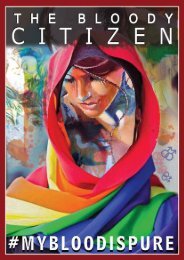The Bloody Citizen
The Bloody Citizen’ is a work of the NGO Khoon. It is an effort to educate its readers about Blood. With articles related to precautions, instructions, myths & reality etc, it talks about various topics under this huge umbrella and persuades the readers to donate blood and save lives. It uses the power of pen, and the beauty of prose & poetry, to get the message across. ‘The Bloody Citizen’, being the first of its kind, wishes to spread the word and bridge the gap to bring significant information to your doorstep in a way that one can easily understand.
The Bloody Citizen’ is a work of the NGO Khoon. It is an effort to educate its readers about Blood. With articles related to precautions, instructions, myths & reality etc, it talks about various topics under this huge umbrella and persuades the readers to donate blood and save lives. It uses the power of pen, and the beauty of prose & poetry, to get the message across. ‘The Bloody Citizen’, being the first of its kind, wishes to spread the word and bridge the gap to bring significant information to your doorstep in a way that one can easily understand.
Create successful ePaper yourself
Turn your PDF publications into a flip-book with our unique Google optimized e-Paper software.
Why do we need Vitamin D?<br />
From pregnancy to the infancy, from childhood<br />
to old age, every age has its own requirements<br />
for Vitamin D. In pregnant<br />
women, it results in uncomplicated pregnancy<br />
and developed immune systems while<br />
it helps infants acquire strong and healthy<br />
bones. Children are helped in growth and<br />
development such as building strong teeth<br />
and immune systems. It aids adults in protecting<br />
themselves against cancer and also<br />
in regulating blood pressure. Elderly people<br />
may have a stronger balance and reduced<br />
risks of falling. It also helps them in digestion.<br />
Since the natural source of Vitamin D<br />
(Sunlight) is present in abundance, why<br />
are people increasingly falling a victim<br />
to it’s deficiency?<br />
We get 97% of Vitamin D from the sun; our<br />
bodies make it when it’s exposed to the UV<br />
rays. However, people do not spend alot of<br />
time under sunlight. Ideally, 10-15 minutes<br />
of UVB per day with 40% of our skin<br />
exposed is necessary. It is best if exposed<br />
during the early hours of the day.<br />
How can a person know that s/he is facing<br />
this deficiency?<br />
Common symptoms include weakness in<br />
the body; a person generally feels down due<br />
to lack of Vitamin D. Obesity, bone pain,<br />
face sweat, dry and flaky skin, and an upset<br />
digestive system are some indicators of this<br />
problem.<br />
What are the risks associated with the<br />
lack of it in our bodies?<br />
Brittle bones, muscle weakness and pain,<br />
poor cardiovascular health, depression, and<br />
inflammation are some of the risks of not<br />
getting enough Vitamin D.<br />
It may also lead to cancer and diabetes in<br />
some cases. Ageing people usually face more<br />
complications than the rest.<br />
Who is in danger of suffering from deficiency<br />
of Vitamin D? How is age a factor?<br />
Age has a role to play, the elderly and infants<br />
are more prone to this deficiency. As<br />
a person enters old age, the body loses the<br />
ability to generate the vitamin. As for infants,<br />
human breast milk contains low levels<br />
of vitamin D. Overweight people are also<br />
at risk because it is oil soluble and hides in<br />
fat. Pregnant women may also face it more<br />
than others because of high blood pressure<br />
or preeclampsia. Other than these, darkskinned<br />
people have a disadvantage too because<br />
their pigmentation blocks UVB radiation.<br />
What are the tests a person can get<br />
checked for?<br />
A person can go for blood tests such as<br />
Total Vitamin D or Vitamin D3.<br />
What are some medicines that help in<br />
its treatment?<br />
Medicines come in three forms: powdered,<br />
tablets and injectable. <strong>The</strong> purpose is to<br />
increase the dosage of the vitamin in your<br />
body. <strong>The</strong> treatment depends on the severity<br />
of it and it is best to consult a doctor for<br />
the specific treatment you need.<br />
What are some sources that can be included<br />
in our diet?<br />
Food sources include cheese, margarine,<br />
butter, fortified milk, healthy cereals, and<br />
fatty fish.<br />
23





